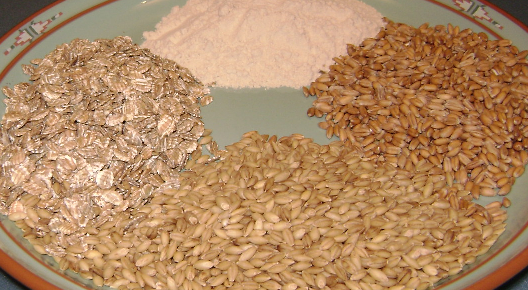
Photograph of 4 gluten sources. Top – gluten flour, Right – European Spelt, Bottom -Barley, Left – Rolled Rye flakes. Author/Camera – Pdeitiker. Wikimedia Commons.
After realizing he had a 8 out of 10 match on “signs you may be gluten intolerant“, my husband has agreed to do a gluten intolerance test by going 1 month gluten free. I’ve known about this overlap for a while (and mentioned it to him a couple years ago), but doing what is a rather radical change to diet really has to come from the person who needs it, not anyone else (children are of course an exception to this rule). He’s onboard, so there’s much less of a chance of “cheating” which really invalidates the test.
As the person who does all the cooking, I figure it’s just easiest to do it with him. Also, it certainly wouldn’t hurt to find out what effect gluten has on my system. I figure it’s best to plan this month out as best as possible, so that there’s enough gluten-free food available that we don’t end up stuck. Here’s how I approached going gluten free.
Step 1: Find out what gluten free means
There are plenty of lists out there that give lists of what you can and cannot eat. Something like this one on Gluten Free Living are very useful, and can help you learn the little “gotchas” like soy sauce, which is only gluten free if the label says so. Guidelines are very helpful for my husband, who may end up having to eat meals away from home.
Step 2: Find recipes you like
First, I looked through my favorite recipes on my google cookbook and saw what’s already gluten free. I have several recipes that have never had gluten or could easily be adjusted, so those are easy choices of items to include in the month because I already know I like them. I’m a huge Pinterest fan, and a search for gluten free boards brought up a large number of ideas, many of which I added to my Pinterest Food Board. Not all the recipes that come up are actually gluten free, but with a bit of modifications could be made to be so. Having this huge trove of ideas (complete with pictures) is a great boon, and was much more useful than just doing a web search for gluten free recipes. I’m a rather picky eater too, so I’ll skip a lot of what other people think is yummy and go for items with ingredients I like. For example, I loathe bananas. The smell makes me nauseous. So anything that uses bananas as a substitute is definitely not an option. But I’m finding plenty of other items out there that look like yummy choices to try, like Loaded Baked Potato & Chicken Casserole and Philly Cheesesteak Stuffed Bell Peppers, or these Grain Free Peanut Butter Chocolate Chip Cookie Dough Bites.
Step 3: Make a menu
I shop monthly, with some small trips to buy fresh ingredients like milk and veggies. So my menu is monthly. by planning in advance based on my knowledge of our calendar (Mondays and Wednesdays I have little time to cook, Tuesdays my husband may be going off to fencing practice so I’m usually on my own, every other Friday we have guests for game night who may need to eat dinner, etc…) I can better prepare and buy veggies in advance but not so far ahead that they go bad. My biggest gotchas here are lunches and breakfasts, I hope I have enough to cover.
Step 4: KnowMy Own Weaknesses
Knowing myself (and my husband) as well is really key. I can’t cook dinner every night. I get a huge case of the “idonwannas”, and we end up going out to dinner. Leftovers/slow cooker foods are key to overcoming this problem. My husband, while up for this gluten-free month idea, is very leery about trying gluten free bread/pasta so I will only have a couple of test meals that use it. He also does not like soup, which would be the easiest of lunch ideas. I have neither the time nor the inclination to cook breakfast in the mornings, so quick grab-and-go food is key.
Tomorrow morning it begins, this evening will be food shopping. Wish me luck.
